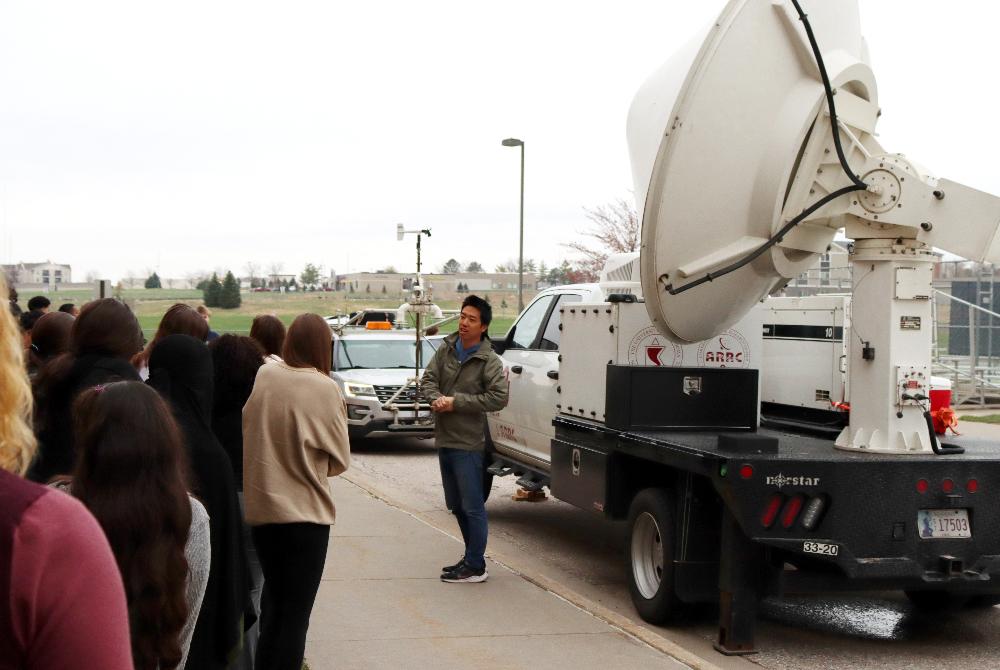Doppler Discoveries: Gators explore weather radar systems during geoscience presentation
April 23, 2025
If a weather radar system could detect an increase in scientific knowledge, it would have picked up a strong signal at North Star High School this spring.
Students enrolled in geoscience classes learned how meteorologists locate and track storms during an interactive presentation on campus. Adam Houston, a professor at the University of Nebraska-Lincoln’s Department of Earth and Atmospheric Sciences, talked with dozens of Gators about technology he and other weather researchers use every day. Students were then able to view a spinning mobile radar system attached to a truck outside the building.
North Star students Titus and Shaurya both said they were happy with what they had learned. Houston described the differences between mobile and fixed radar images to the classes, and he talked about the many objects that radar systems can detect. He also explained how meteorologists can help people stay safe when severe weather strikes in Nebraska.
“I thought it was cool that they were able to do this,” Titus said. “I enjoyed it.”
“What I really liked was how all the presentation and the visuals were really clear,” Shaurya said. “You could see every part of it. There was a key on each of the sample pictures so you’d know how fast the wind was moving.”
Karen Covil leads North Star’s science department and teaches geoscience classes to students in grades 9-12. She said Houston’s visit reinforced the Next Generation Science Standards (NGSS) that are used throughout Lincoln Public Schools.
The presentation also came nearly one year after an EF3 tornado moved across the northern edge of Lincoln on April 26, 2024. The tornado came close to North Star’s campus and caused significant damage in Lancaster County.
“Last year, many students experienced for the first time the impact of a high-end EF3 tornado that struck Lancaster County,” Covil said. “This was a terrifying occurrence for students, especially if they lacked significant experience with the safety procedures in the event of this type of weather and how storm spotters and meteorologists are helping to keep us safe.”
Houston focused his presentation on radar (radio detection and ranging) systems, which transmit pulses of microwave radiation to identify objects. Radars use the strength of reflected signals to determine the size of objects such as raindrops and hailstones. Since many other objects reflect energy pulses, radar systems can also detect birds, bugs and smoke plumes.
Doppler radar systems use the Doppler effect to measure the speed of a storm. Sound moves through the air as a series of waves, and these waves change length if they are moving toward or away from a source. This creates a higher pitch if the moving source approaches our ears and a lower pitch if it is leaving us.
The same effect takes place in the atmosphere when a pulse of energy from a NEXRAD (Next Generation Radar) system strikes an object. The energy is reflected back toward the radar, which can then measure how fast the object is traveling either toward or away from the radar’s location. This ability to “see” the wind is what allows meteorologists to view the formation of tornadoes and supercell storms.
Radar systems that are fixed in one location have a limited range because of the earth’s curvature, but mobile radars like the one North Star students looked at are more flexible. Titus said he was interested in watching the mobile Doppler radar dish spinning on a weather monitoring truck. He then approached Houston after the presentation and asked him several questions about the equipment.
“I think it’s cool that they’re able to go so close to the storms and detect these things,” Titus said.
Shaurya said the radar presentation came at a good juncture in the geoscience course. Students are ready to begin a new unit about storms and other weather-related topics. By the end of the semester, he and other Gators will be familiar with how the energy transfer from the sun to earth creates an unequal heating of our planet’s surface. This leads to air pressure differences, wind patterns and storm development, which are all key ingredients of weather forecasting.
“We can predict if the weather’s going to change or if there’s a thunderstorm that might affect our property or something like that, which is interesting,” Shaurya said. “We can take precautions to protect our property and protect us.”
Covil felt Houston’s visit allowed her students to gain a deeper understanding of science, technology, engineering and math (STEM) concepts. She said this would motivate many Gators to explore STEM topics even more as they move through high school.
“Students benefit from seeing the real-life work of scientists in the field,” Covil said. “This provides valuable mentorship opportunities as well as inspiration to students when considering what they might like to do for future STEM careers.”
Visit home.lps.org/science to learn more about science courses at LPS and how they are helping students expand their academic horizons.
Do you have a story idea? Share it with the LPS Communications Team by filling out this form!
Published: April 23, 2025, Updated: April 23, 2025
North Star High School students listen to a presentation in front of a mobile radar system this spring. They learned about mobile and fixed radar images, how radar systems use the Doppler effect and how weather forecasters use the information to keep people safe.

